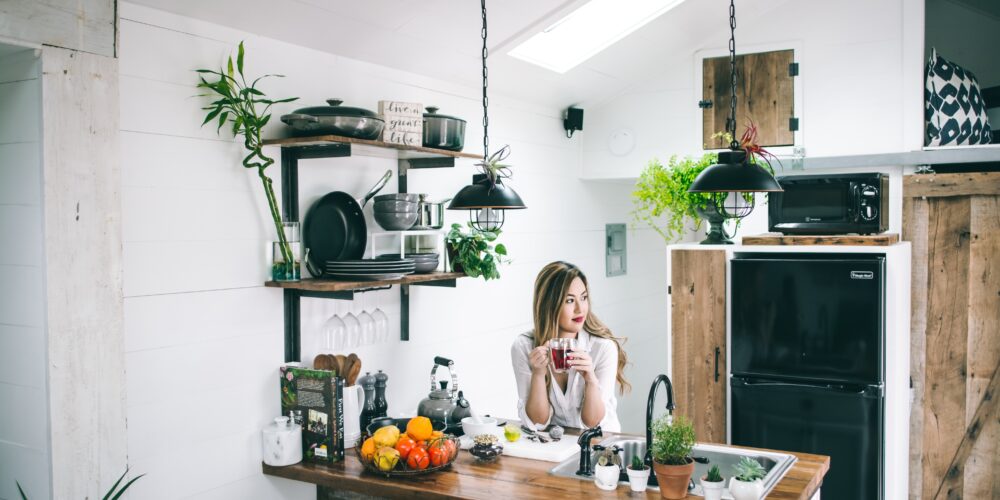
Sustainable Modern Kitchens: Embracing Eco-Friendly Design for a Greener Future
In today’s world, sustainability and eco-friendliness have become essential considerations in every aspect of our lives, including kitchen design. Sustainable modern kitchens are not only environmentally responsible but also offer a host of benefits for homeowners, from reduced energy consumption to healthier living spaces. By making conscious choices in materials, appliances, and design, you can create a sustainable kitchen that reflects your commitment to a greener future. In this blog post, we’ll explore various strategies and ideas for designing sustainable modern kitchens.
1. Eco-Friendly Materials
One of the foundations of a sustainable modern kitchen is the use of eco-friendly materials. Opt for renewable, recycled, or reclaimed materials for your countertops, cabinets, and flooring. Sustainable options such as bamboo, cork, and reclaimed wood not only add natural warmth and character to your kitchen but also help conserve valuable resources. Additionally, choose low-VOC (volatile organic compounds) finishes for your cabinetry and paints to improve indoor air quality and reduce harmful emissions.
2. Energy-Efficient Appliances
Selecting energy-efficient appliances is a significant step towards sustainability in your kitchen. Look for appliances with an Energy Star rating, as they meet strict energy efficiency guidelines set by the U.S. Environmental Protection Agency (EPA). Energy-efficient refrigerators, dishwashers, and cooking ranges not only reduce your carbon footprint but also lower your utility bills over time. Consider investing in induction cooktops, which are more energy-efficient than traditional gas or electric cooktops, and convection ovens that cook food faster and at lower temperatures.
3. LED Lighting
Lighting is an essential aspect of any kitchen design, and opting for LED (light-emitting diode) lighting is a sustainable choice. LED lights are energy-efficient, using up to 75% less energy than traditional incandescent bulbs and lasting significantly longer. They also emit less heat, which helps keep your kitchen cooler during warmer months. Choose LED fixtures for under-cabinet lighting, recessed lighting, and pendant lights to brighten your kitchen while saving energy and reducing maintenance costs.
4. Water-Efficient Fixtures
Incorporating water-efficient fixtures is another important element of sustainable kitchen design. Choose low-flow faucets and aerators that reduce water usage without compromising water pressure. Install a water-saving dishwasher that uses less water per cycle, and consider a dual-function sink faucet with a spray option to minimize water waste. Additionally, fixing any leaks promptly can help conserve water and prevent unnecessary water consumption.
5. Recycling and Waste Management
Make recycling and waste management a seamless part of your sustainable kitchen design. Install pull-out recycling bins and compost bins within your cabinetry to encourage proper waste separation and disposal. Label the bins clearly to make recycling easy for everyone in the household. By incorporating these features into your kitchen, you contribute to reducing the amount of waste sent to landfills and promote a more sustainable waste management system.
6. Natural Ventilation
Whenever possible, take advantage of natural ventilation to reduce reliance on mechanical cooling and ventilation systems. Position windows strategically to facilitate cross-ventilation, allowing fresh air to circulate and cool your kitchen naturally. Natural ventilation not only reduces energy consumption but also creates a more pleasant and comfortable cooking environment.
7. Sustainable Flooring
Choosing sustainable flooring options is essential for a green kitchen. As mentioned earlier, materials like bamboo and cork are eco-friendly choices due to their rapid renewal rates and minimal environmental impact. Additionally, consider using tiles made from recycled materials or reclaimed wood for a unique and sustainable flooring solution.
8. Efficient Space Planning
Efficient space planning is a key principle of sustainable kitchen design. By optimizing your kitchen layout and creating a functional work triangle, you can minimize unnecessary movement and energy expenditure during meal preparation. Utilize storage solutions like pull-out drawers and organizers to keep your kitchen essentials organized and easily accessible, reducing the need to search for items and saving valuable time and energy.
9. Local and Sustainable Sourcing
When selecting materials and products for your kitchen, prioritize locally sourced and sustainably produced items. Buying local reduces the carbon footprint associated with transportation, and supporting sustainable practices encourages eco-friendly manufacturing processes. Look for certifications like Forest Stewardship Council (FSC) for wood products and Cradle to Cradle (C2C) for environmentally safe and recyclable materials.
10. Long-Term Durability
Designing a sustainable kitchen involves thinking long-term. Choose durable materials and high-quality products that will withstand the test of time and require less frequent replacement. Investing in long-lasting items not only reduces waste but also saves money in the long run.
Conclusion: Creating Your Sustainable Modern Kitchen
In conclusion, sustainable modern kitchens are a testament to our commitment to environmental responsibility and a healthier living environment. By using eco-friendly materials, energy-efficient appliances, and LED lighting, you can reduce your kitchen’s impact on the planet while enjoying the benefits of lower energy costs and improved indoor air quality. Incorporate water-efficient fixtures, recycling and waste management systems, and natural ventilation to further enhance the sustainability of your kitchen. Optimize space planning and choose durable, locally sourced materials to create a kitchen that is both functional and environmentally friendly. By embracing sustainable kitchen design, you can make a positive impact on the planet and enjoy a beautiful and eco-conscious culinary space for years to come.
